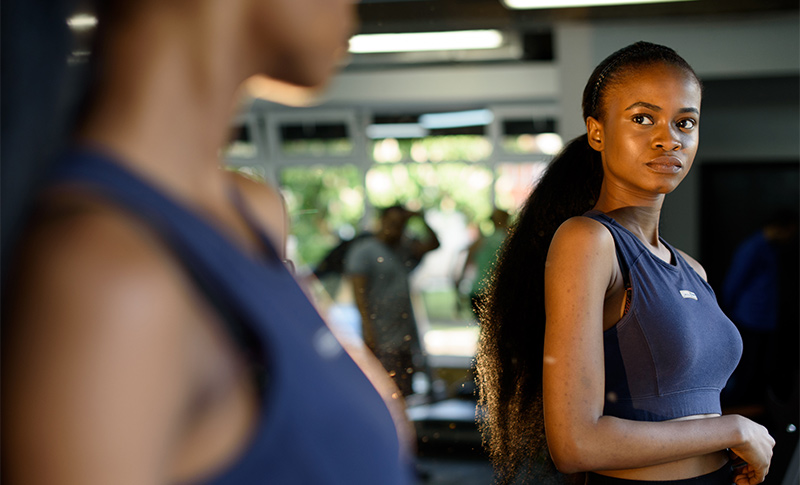Many of you have childhood memories of your parents saying, “Stand up straight” and “Don’t slouch.” At the time, it seemed like just one more rule or annoyance that made you roll our eyes. Little did you know that their admonitions were not empty instructions, but a prescription for better health as you age.
What is Proper Posture?
It varies, depending on whether you are sitting or standing. When sitting at a desk, your knees should be level with your hips and your feet should be flat on the floor. Crossing your legs can impair circulation. If you are standing, try to stand with weight distributed equally on both legs. Your shoulders should be back and your chest slightly out with the ears positioned over the shoulders.
Why is Good Posture so Important?
It can keep you looking younger and staying healthier as you age. Proper posture helps prevent a myriad of health issues, including:
- Decreased range of motion. Your muscles and ligaments can tighten or stretch if you regularly sit in a slumped position. Once this happens, these muscles and ligaments don’t function properly.
- Decreased lung capacity. Good posture allows the appropriate amount of air to flow through your lungs. Otherwise, your chest cavity may decrease in size and prevent your lungs from functioning properly.
- Low back pain. A major consequence of poor posture.
- Increased discomfort. Poor posture can lead to headaches and pain in your shoulders, arms and hands.
- Jaw pain. If your head is thrust forward, it can result in temporomandibular joint disease, once considered solely a dental problem.
- Spine misalignment and rounding. Poor posture can result in a spine that is out of position and may lead to interference in nerve function. Osteoporosis can cause compression or destruction of vertebrae.
How to Maintain Good Posture?
Now that you have incentive to stand tall, how can you make sure you maintain good posture? It’s not as difficult as you may fear; it just requires a bit of time and effort.

Try these approaches:
- Stay limber. If you spend most of your day sitting at a desk or in front of a computer, it’s important to maintain a good range of motion. Get up for a few minutes each hour and stretch your arms overhead with fingers interlaced or walk around a bit to keep the body moving.
- Stay flexible. Each morning, lie on the floor and make snow angels for a few minutes to stretch your muscles. You can challenge yourself by placing a foam roller or a rolled up towel under your spine for an extra stretch. Go slowly and stop if you feel anything other than mild discomfort.
- Sit up straight. Good posture while sitting is a habit worth cultivating. It requires strong core muscles, so consider some strengthening exercises, yoga or Pilates; the abdomen is the heart of good posture and helps improve everything from urinary incontinence to sex.
- Correct your computer. If you work at a computer, be sure that your eyes are level with the screen and that your arms and wrists are straight and parallel to the floor.
- Strengthen your spine. Women have weakening around the spine after menopause so it’s crucial to keep the surrounding muscles strong. Strong spine and trunk muscles are especially important when you need to stand for long periods of time. Inquire at your gym about exercises or machines that strengthen the back extensors, neck flexors, pelvic muscles, and side muscles.
- Add some weight. Build some weight-bearing exercises into your routine. Osteoporosis, the disease that thins your bones, can cause vertical compression fractures that make us shorter as we age and even lead to dowager’s hump. Weight-bearing exercises help prevent a loss of bone density, so consider lifting weights, walking or climbing stairs to keep you tall and strong.
- Check your calcium intake. Calcium is important for building strong bones. Women between the ages of 19 and 50 need 1,000 milligrams daily; after 50, the recommended dose increases to 1,200 mg. Usually, a healthy diet provides the necessary amount, but there are supplements available, although they may make you more susceptible to other health problems.
Monitoring your Posture
It’s never too early or too late in life to improve posture. Before you undertake an exercise regimen, document your current posture to establish a baseline for future comparison.

Put on your exercise gear or wear comfortable clothes and ask someone to take full-length photos of you from the front, the side and the back. If you do this once a year, you can see if changes are taking place and work to correct them. In addition, monitor your posture as you walk past mirrors to ensure that you are standing tall.
Remember, although everyone ages, numerical age can also be a state of mind – and body. If you have good posture, you’ll look younger and feel younger, too.
